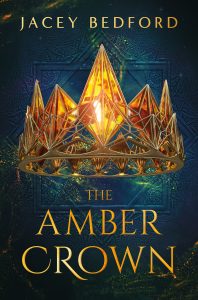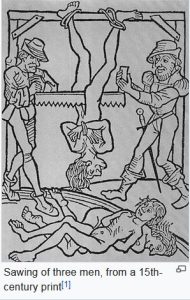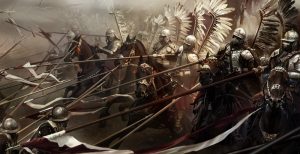[Editor’s Note: This is a guest post from the British writer Jacey Bedford, whose latest book, The Amber Crown, came out January 11.]
By Jacey Bedford
 The king is dead, his queen is missing. On the amber coast, the usurper king is driving Zavonia to the brink of war. A dangerous magical power is rising up in Biela Miasto, and the only people who can set things right are a failed bodyguard, a Landstrider witch, and the assassin who set off the whole sorry chain of events.
The king is dead, his queen is missing. On the amber coast, the usurper king is driving Zavonia to the brink of war. A dangerous magical power is rising up in Biela Miasto, and the only people who can set things right are a failed bodyguard, a Landstrider witch, and the assassin who set off the whole sorry chain of events.
I love stealing from history for my fantasy books. When I was researching for The Amber Crown, which has a Baltic setting, I found some fantastic nuggets from the pages of history that turned into inspiration. I offer two examples, one so gory and grim that it makes you wonder who thought it up in the first place, and whether they were entirely sane. The other is so fantastic that my critique group thought I’d made it up, but I just transplanted it straight from history.
Grim enough to be Grimdark
Let’s get the grim one out of the way first – execution by sawing. I don’t put this on the page in all its gory detail, but  one character thinks it might be his fate, another reflects on it after seeing it take place. We tend to know about hanging, drawing and quartering. The drawing by the way was being drawn to the place of execution on a hurdle, not having the guts drawn out of the belly while still alive. So the victim was drawn through the streets, hanged and then his body cut into quarters. So really it should be drawn, hanged and quartered, in that order.
one character thinks it might be his fate, another reflects on it after seeing it take place. We tend to know about hanging, drawing and quartering. The drawing by the way was being drawn to the place of execution on a hurdle, not having the guts drawn out of the belly while still alive. So the victim was drawn through the streets, hanged and then his body cut into quarters. So really it should be drawn, hanged and quartered, in that order.
Accounts differ, but sawing, with a two-handed saw, could be across the body, or lengthways down the body starting at either end. The medieval illustration in Wikipedia shows that they tied the victim upside down on a frame, legs apart, and then began to saw them in half, lengthways, starting at the crotch. The theory was that because they were upside down the blood drained towards the head and so they didn’t bleed out, or pass out, quickly, but stayed alive and screaming while being butchered like an ox. It’s hideous, so I reserved it for traitors and king killers. In The Amber Crown it’s a character we haven’t met who suffers this fate, so it’s not as personal as if it’s a character we’ve already become invested in, though, sadly, it is an innocent man.
Fantastic, but real.
There’s joy in finding history that fits your story perfectly. The joyous real thing that I found is the Polish Winged Hussaria. I borrowed the idea because it was simply too good to ignore. The Polish Hussars rode into battle with six foot wings made of a wooden frame with eagle, ostrich or swan feathers attached. You might ask why, and no one really knows how it came about, but the tangible result was shock and awe.
 They rode swift and manoeuvrable horses bred from the horses of the Tatar tribes. Armed with lances for the initial charge, sabres, two pistols, a carbine, and often a war hammer or battle axe, they were the pre-eminent cavalry force in Europe from the 1570s to 1770s. They helped to win many battles, often against a much larger force, playing a significant role in breaking the Siege of Vienna in 1683. Their tactic was to ride towards the enemy slowly, in loose formation. Then as they approached they closed ranks and formed up knee to knee. When they were within striking distance they would charge forwards with their long lances, their great wings towering ten feet over the enemy, and the wind singing through the feathers. It’s no wonder the enemy turned and fled.
They rode swift and manoeuvrable horses bred from the horses of the Tatar tribes. Armed with lances for the initial charge, sabres, two pistols, a carbine, and often a war hammer or battle axe, they were the pre-eminent cavalry force in Europe from the 1570s to 1770s. They helped to win many battles, often against a much larger force, playing a significant role in breaking the Siege of Vienna in 1683. Their tactic was to ride towards the enemy slowly, in loose formation. Then as they approached they closed ranks and formed up knee to knee. When they were within striking distance they would charge forwards with their long lances, their great wings towering ten feet over the enemy, and the wind singing through the feathers. It’s no wonder the enemy turned and fled.
And there’s the Swedish heavy metal band, Sabaton’s song about the Winged Hussars breaking the siege of Vienna: https://youtu.be/rcYhYO02f98
And some history: https://youtu.be/K_L5acJht3g
Enjoy.
Jacey Bedford is a British writer of science fiction and historical fantasy. She is published by DAW in the USA. Her Psi-Tech and Rowankind trilogies are out now. Her new book is The Amber Crown, published in January 2022. Her short stories have appeared in anthologies and magazines on both sides of the Atlantic, and have been translated into Estonian, Galician, Catalan and Polish. In another life she was a singer with vocal trio, Artisan, and once sang live on BBC Radio4 accompanied by the Doctor (Who?) playing spoons.
Psi-Tech and Rowankind trilogies are out now. Her new book is The Amber Crown, published in January 2022. Her short stories have appeared in anthologies and magazines on both sides of the Atlantic, and have been translated into Estonian, Galician, Catalan and Polish. In another life she was a singer with vocal trio, Artisan, and once sang live on BBC Radio4 accompanied by the Doctor (Who?) playing spoons.
- Blog: jaceybedford.wordpress.com
- Facebook: https://www.facebook.com/jacey.bedford.writer
- Twitter: @jaceybedford
- Website/mailing list: http://www.jaceybedford.co.uk
Artisan: http://artisan-harmony.com

Very cool stuff!